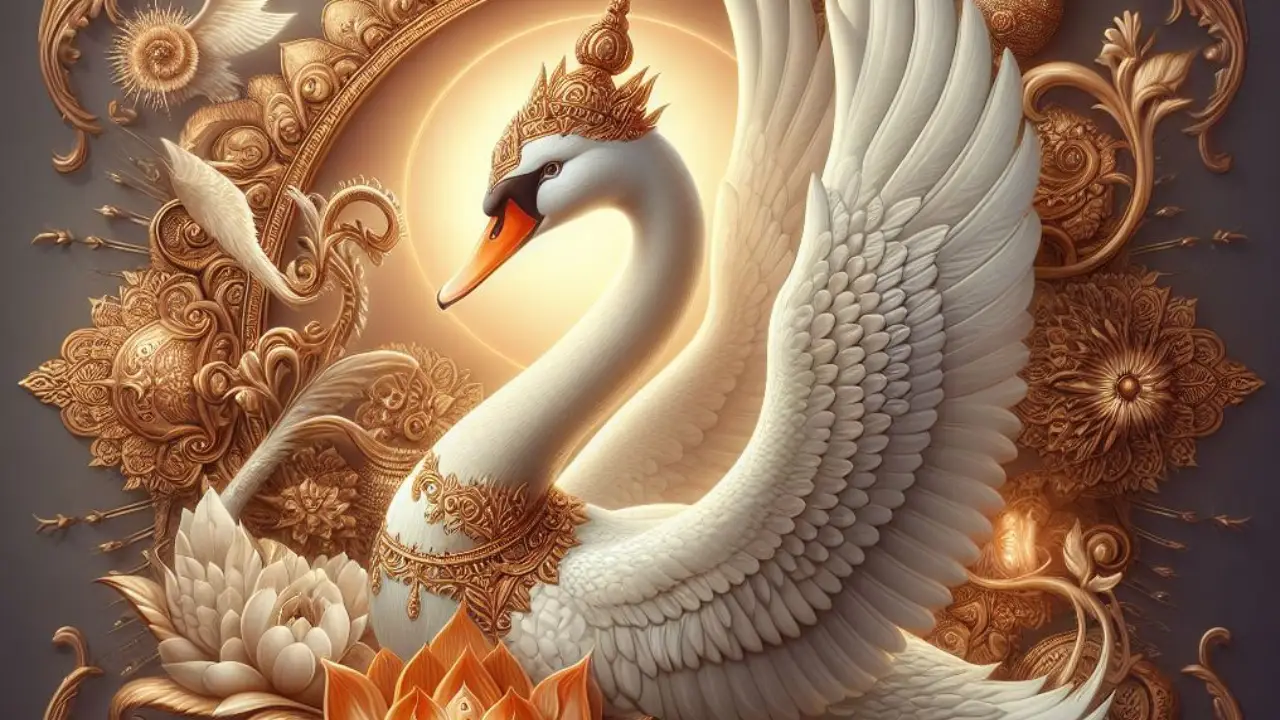Legend has it that in the cosmic dance of creation, Lord Brahma, the creator of the universe, took on many forms to fulfill his divine duties. Among these forms, one of the most intriguing and enigmatic is that of the Hamsa, a sacred bird often associated with purity and transcendence. Today, we embark on a journey to unravel the secrets of this mystical avatar and explore its significance in Hindu mythology.
The Mythical Origins
In the vast tapestry of Hindu mythology, the story of Lord Brahma’s Hamsa avatar holds a special place. According to ancient texts, when the universe was still in its primordial state, Lord Brahma sought a way to bring order and harmony to the chaotic cosmos. It is said that he assumed the form of a majestic Hamsa, adorned with resplendent plumage and exuding an aura of divine grace.
The Symbolism
The Hamsa, often depicted as a graceful swan or goose, carries deep symbolic significance in Hindu tradition. It is believed to possess the ability to separate milk from water. It symbolizes the discernment between truth and illusion, purity and impurity. In the context of Lord Brahma’s avatar, the Hamsa represents the transcendence of worldly boundaries and the pursuit of spiritual enlightenment.
The Divine Attributes
As the Hamsa, Lord Brahma embodies the qualities of wisdom, discernment, and purity. He possesses the power to dispel darkness and ignorance, guiding seekers on the path to self-realization. In Hindu iconography, the Hamsa often depicts with a lotus flower, symbolizing purity of heart, and a sacred book, representing divine knowledge.
The Legacy
Throughout the ages, the story of Lord Brahma’s Hamsa avatar has inspired countless devotees and seekers of truth. Its message of transcendence and spiritual awakening continues to resonate with people from all walks of life. It reminds us of the eternal quest for enlightenment and liberation.
Hindu Iconography
In Hindu iconography, the Hamsa is not merely a bird but a symbol of profound spiritual significance. Intricate sculptures and paintings often depict its graceful form adorning temples and sacred spaces. The Hamsa portrays multiple heads, symbolizing its ability to discern truth from falsehood in all directions. Its wings represent the expansiveness of divine consciousness, encompassing all realms of existence.
Hindu Scriptures
Various Hindu scriptures, including the Vedas, Upanishads, and Puranas, mention the Hamsa. The Rigveda, one of Hinduism’s oldest scriptures, praises the Hamsa as a symbol of divine knowledge and cosmic order. The Upanishads describe it as the vehicle of the god Brahma, carrying him across the celestial waters of creation. In the Puranas, the Hamsa is often linked with the god Vishnu, who is said to ride upon it as he traverses the cosmos.
Hindu Rituals and Ceremonies
The Hamsa plays a prominent role in various Hindu rituals and ceremonies, symbolizing purity, auspiciousness, and divine protection. It is often invoked during sacred rites such as weddings, housewarmings, and religious festivals. In some traditions, devotees offer prayers and offerings to the Hamsa as a gesture of reverence and devotion. They seek its blessings for prosperity and spiritual growth.
Yoga and Meditation
In the practice of yoga and meditation, the Hamsa holds deep significance as a symbol of breath and consciousness. The word “Hamsa” itself is derived from the Sanskrit words “ham” and “sa,” which represent the inhalation and exhalation of the breath, respectively. Yogis and spiritual seekers often meditate on the mantra “So-Ham,” identifying themselves with the divine consciousness symbolized by the Hamsa.
Contemporary Culture
In modern times, the symbolism of the Hamsa has transcended its religious and cultural origins. It has become a widely recognized symbol of spirituality and protection. People often adorn jewelry, clothing, and home decor with it, as it serves as a reminder of the eternal quest for truth and enlightenment. The Hamsa’s popularity has spread across the globe. It is embraced by people of diverse backgrounds who seek meaning and inspiration in its timeless wisdom.
Guide on the Spiritual Path
Ultimately, the Hamsa serves as a guide and companion on the spiritual journey. It reminds us to remain vigilant in our quest for truth and enlightenment. Like the graceful swan that soars above the waters, may we cultivate the qualities of discernment, purity, and transcendence as we navigate the complexities of existence. And may the wisdom of Lord Brahma’s Hamsa avatar continue to illuminate our path, leading us ever closer to the divine light of self-realization.
Exploring the Mysteries
Generations have passed down the tale of Lord Brahma’s Hamsa avatar, yet its deeper meanings and esoteric teachings shroud it in mystery. Some scholars interpret the Hamsa as a metaphor for the soul’s journey towards liberation. Others see it as a symbol of cosmic harmony and balance.
Real-Life Parallels
Various cultural and spiritual traditions around the world incorporate the symbolism of the Hamsa. In ancient Egyptian mythology, depictions of the goddess Isis with wings resemble the graceful form of the Hamsa. Similarly, Jewish mysticism refers to it as the Hand of Miriam, symbolizing protection and blessings.
Embracing the Wisdom
As we contemplate the mysteries of Lord Brahma’s Hamsa avatar, let us reflect on the timeless wisdom it imparts. In a world filled with distractions and illusions, may we strive to cultivate the discernment and purity of heart symbolized by the graceful swan. And may we always remember that the journey towards enlightenment is not merely a quest for knowledge, but a sacred pilgrimage of the soul.
What are your thoughts on the symbolism of the Hamsa in Hindu mythology? Have you encountered similar themes in other spiritual traditions? Share your insights and reflections in the comments below!

